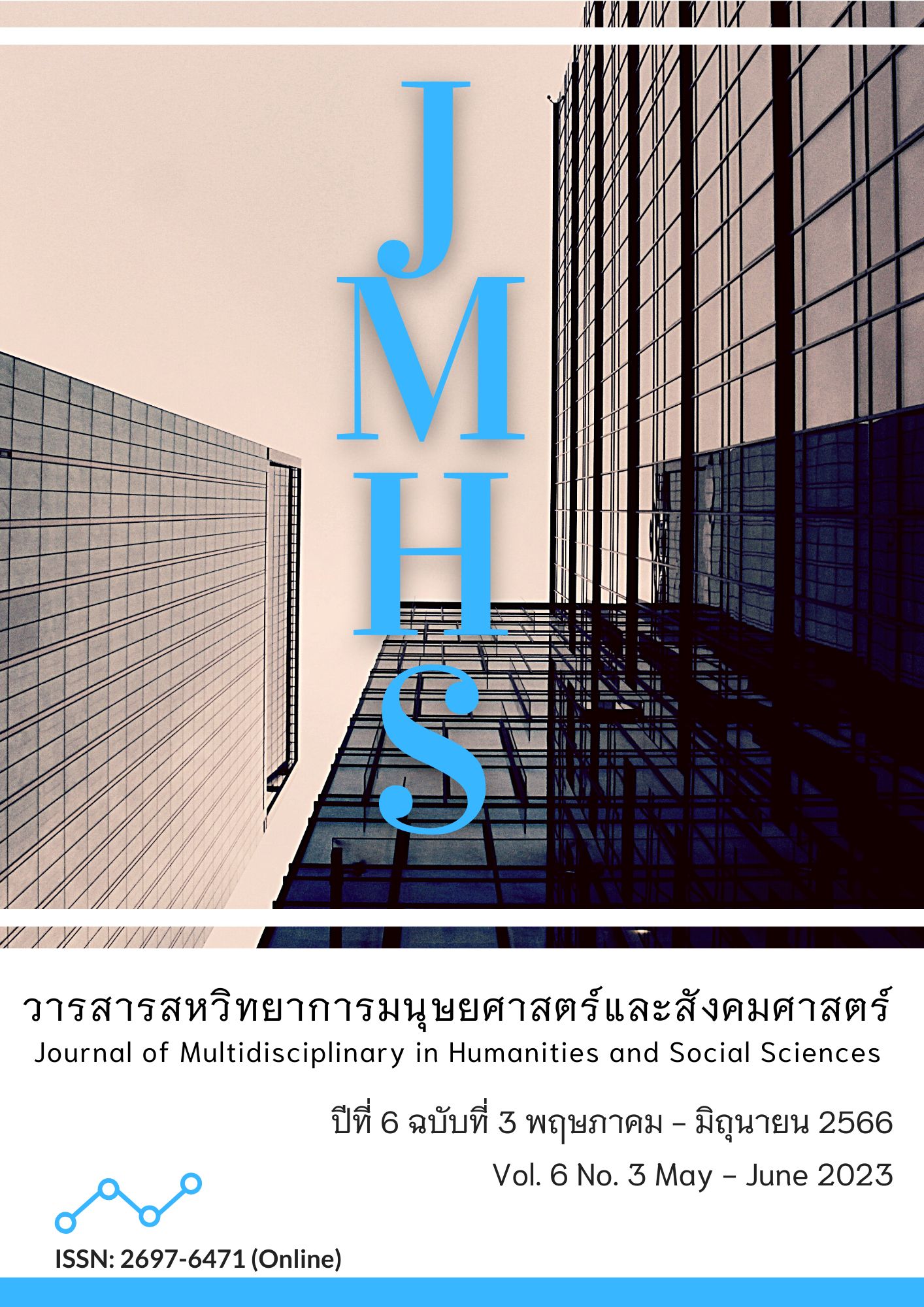The Development of Causal Relationship Model Affecting High Performance Organization of Secondary Schools Under The Office of The Basic Education Commission
Main Article Content
Abstract
The purposes of this research were as follows: (1) to study the level of digital leadership, personnel competency, organizational culture, and strategies in a high-performance organization; (2) to develop and validate the causal relationship model affecting high-performance organizations in secondary schools under the authority of the Office of the Basic Education Commission. The samples in this research were the director's, a total of 873 people. The tool used to collect the data for this research was a five-point questionnaire. The statistics in the data analysis were basic statistics, confirmatory factor analysis, and structural equation analysis. The research results were as follows: (1) The digital leadership aspect had the highest average score for understanding technology, developing new capabilities, and promoting a collaborative environment. The levels of competency with the highest average score were morality, ethics, and knowledge. The highest average score was student support, followed by participation in thought and action. The strategy level with the highest average score was mission, followed by academic administration using IT. For high-performance organizations, the highest average score was attention to students and good governance, and (2) secondary schools have administrators with digital leadership, high-performing teachers and staff, and an organizational strategy for good work. In addition, school administrators, including the director and deputy director, must drive teachers and school personnel through organizational culture.
Article Details

This work is licensed under a Creative Commons Attribution-NonCommercial-NoDerivatives 4.0 International License.
Views and opinions appearing in the Journal it is the responsibility of the author of the article, and does not constitute the view and responsibility of the editorial team.
References
กัญญารัตน์ สุขแสน และประทุมทอง ไตรรัตน์. (2564). รูปแบบการพัฒนาภาวะผู้นำด้านดิจิทัลของผู้บริหารโรงเรียนในเครือมูลนิธิคณะเซนต์คาเบรียลแห่งประเทศไทย. วารสารสังคมศาสตร์และมานุษยวิทยาเชิงพุทธ, 6(7), 129-146.
จตุพร งามสงวน และสุพัฒนา หอมบุปผา. (2561). รูปแบบการพัฒนาองค์การสมรรถนะสูงของโรงเรียนมัธยมศึกษาขนาดใหญ่พิเศษ สังกัดสำนักงานคณะกรรมการการศึกษาขั้นพื้นฐาน. วารสารมหาจุฬาวิชาการ, 5(1), 101-115.
ฉัตรชัย หวังมีจงมี. (2560). สมรรถนะของครูไทยในศตวรรษที่ 21: ปรับการเรียน เปลี่ยนสมรรถนะ. Journal of HRintelligence, 12(2), 47-61.
ชลธิชา บุนนท์ และคณะ. (2564). การศึกษาองค์ประกอบขององค์กรสมรรถนะสูงของสถานศึกษาสังกัดสำนักงานเขตพื้นที่การศึกษามัธยมศึกษาเขต 21. (การประชุมวิชาการเสนอผลงานวิจัยระดับบัณฑิตศึกษาแห่งชาติ ครั้งที่ 22). มหาวิทยาลัยขอนแก่น.
ตฤณ แพเขียว และ กิติยา ทัศนะบรรจง. (2565). ผลกระทบของคุณลักษณะของผู้ประกอบการลักษณะองค์กรตามองค์ประกอบขององค์กรสมรรถนะ สูงต่อการเจริญเติบโตของวิสาหกิจขนาดกลางและขนาดย่อมของภาคธุรกิจการเกษตรในภูมิภาค ตะวันออกของประเทศไทย. วารสารวิชาการวิทยาลัยสันพล, 8(2), 116-125.
ทินกร บัวชู และ ทิพภาพร บัวชู. (2562). ภาวะผู้นำดิจิทัลของผู้บริหารสถานศึกษา. วารสารครุศาสตร์สาร: Journal of Educational Studies, 13(2), 285-294.
ทิพวรรณ หล่อสุวรรณรัตน์. (2551). องค์การสมรรถนะสูงกับความรับผิดชอบต่อสังคม. วารสารการจัดการภาครัฐและเอกชน, 15(2), 11-35.
นิสา ธิปัตย์, พร้อมพิไล บัวสุวรรณ และ สุดารัตน์ สารสว่าง. (2563). ปัจจัยเชิงสาเหตุที่ส่งผลต่อการเป็นองค์กรสมรรถนะสูงของกรมแพทย์ทหารบก. วารสารสถาบันวิชาการป้องกันประเทศ, 11(2), 103-118.
ปวลิน โปษยานนท์. (2557). การพัฒนารูปแบบเชิงโครงสร้างองค์กรที่มีสมรรถนะสูงของบริษัท ปูนซิเมนต์ไทย (แก่งคอย) จำกัด. วารสารการเมือง การบริหาร และกฎหมาย, 6(3), 303-333.
ประเสริฐ อินทร์รักษ์. (2560). องค์ประกอบการวางแผนกลยุทธ์ในโรงเรียน. Veridian E-Journal, Silpakorn University, 10(3), 1503-1517.
พรทิพย์ สุพรรณกุล. (2553). การพัฒนารูปแบบโรงเรียนสมรรถนะสูงในสถานศึกษาขั้นพื้นฐาน(ดุษฎีนิพนธ์ปรัชญาดุษฎีบัณฑิต สาขาวิชาการบริหารการศึกษา). มหาวิทยาลัยรามคำแหง.
มงคล อติอนุวรรตน์ และคณะ. (2558). การพัฒนาตัวบ่งชี้องค์การที่มีสมรรถนะสูงของโรงเรียนสังกัดองค์การบริหารส่วนจังหวัด. วารสารบริหารการศึกษา มหาวิทยาลัยขอนแก่น, 11(2), 123-131.
วราภรณ์ ทรัพย์รวงทอง, และ สาธร ทรัพย์รวงทอง. (2564). การพัฒนารูปแบบความเป็นองค์กรสมรรถนะสูงในยุคดิจิตอลของสถานศึกษา สังกัดสำนักงานเขตพื้นที่การศึกษามัธยมศึกษานครสวรรค์. วารสารปรัชญาปริทรรศน์, 26(1), 44-52.
เยาวเรศ ตระกูลวีระยุทธ, ศักดา สถาพรวจนา, และ สมบัติ คชสิทธิ์. (2558). รูปแบบการบริหารสถานศึกษาขีดสมรรถนะสูง สังกัดองค์กรปกครองส่วนท้องถิ่น. วารสารบัณฑิตศึกษา มหาวิทยาลัยราชภัฏ วไลยอลงกรณ์ ในพระบรมราชูปถัมภ์, 9(1), 12-25.
วิรัช ประวันเตา, ภัทรเดช วรศรีหิรัญ, ไพรัตน์ อ้นอินทร์, อัจฉราวรรณ ช้างพินิจ, จำเริญ มรฤทธิ์ และ อุษารัตน์ ติดเทียน. (2562). การพัฒนารูปแบบองค์กรที่มีสมรรถนะสูงในการป้องกันควบคุมโรคและภัยสุขภาพระดับจังหวัด. วารสารวิชาการสาธารณสุข, 28(2), 172-184.
ศิริพงษ์ เศาภายน. (2561). หลักการบริหารการศึกษา: ทฤษฎีและแนวปฏิบัติ. (พิมพ์ครั้งที่ 4). กรุงเทพฯ: บุ๊คพ้อยท.
สมาพร ภูวิจิตร, ยุภาพร ยุภาศ และสัญญา เคณาภูมิ. (2558). รูปแบบวัฒนธรรมองค์กรที่มีประสิทธิภาพ. Journal of Nakhonratchasima College, 9(1), 73-77.
สำนักงานคณะกรรมการพัฒนาการเศรษฐกิจและสังคมแห่งชาติ สำนักนายกรัฐมนตรี. (2560). สรุปสาระสำคัญแผนพัฒนาเศรษฐกิจและสังคมแห่งชาติฉบับที่สิบสอง พ.ศ. 2560 – 2564. สืบค้นจาก https://drive.google.com/file/d/18DKqGcId1dN6IWF07TXG8YZsQOg-NlWZ/view
สำนักพัฒนานวัตกรรมการจัดการศึกษา สพฐ. (2564). จำนวนโรงเรียนทั้งหมดแยกตามแต่ละภูมิภาคของสำนักงานคณะกรรมการการศึกษาขั้นพื้นฐาน. สืบค้นจาก https://inno.obec.go.th/
สำนักบริหารงานการมัธยมศึกษาตอนปลาย สพฐ. (2564). ระบบข้อมูลสารสนเทศด้านคุณภาพมัธยมศึกษา. สำนักงานคณะกรรมการการศึกษาขั้นพื้นฐาน. สืบค้นจาก https://sesa.obec.go.th/index.php?name=data&file=geo
สำนักงานคณะกรรมการการศึกษาขั้นพื้นฐาน. (2562). นโยบายสำนักงานคณะกรรมการการศึกษาขั้นพื้นฐาน งบประมาณ พ.ศ. 2562. สืบค้นจาก https://www.obec.go.th/wp-content/uploads/2018/10/OBECPolicy62.pdf
สำนักงานเลขาธิการสภาการศึกษา. (2556). บทวิเคราะห์สถานภาพการพัฒนาครูทั้งระบบและข้อเสนอแนะแนวทางการพัฒนาครูเพื่อคุณภาพผู้เรียน. กรุงเทพฯ: พริกหวานกราฟฟิค.
สรรเพชร โทวิชา, ศักดา สถาพรวจนา และ วิสุทธิ์ วิจิตรพัชราภรณ์. (2560). กลยุทธ์การบริหารสถานศึกษาสมรรถนะสูง สังกัดสำนักงานคณะกรรมการการศึกษามัธยมศึกษา. วารสาร มจร สังคมศาสตร์ปริทรรศน์, 6(2), 25-35.
สุนิสา ธิปัตย์, พร้อมพิไล บัวสุวรรณ และ สุดารัตน์ สารสว่าง. (2563). ปัจจัยเชิงสาเหตุที่ส่งผลต่อการเป็นองค์กรสมรรถนะสูงของกรมแพทย์ทหารบก. วารสารสถาบันวิชาการป้องกันประเทศ, 11(2), 103-118.
สุริยะ ทวีบุญญาวัตร และประเสริฐ อินทร์รักษ์. (2559). รูปแบบองค์การสมรรถนะสูงของโรงเรียนมัธยมศึกษาสังกัดสำนักงานคณะกรรมการการศึกษาขั้นพื้นฐาน. Veridian E-Journal, Silpakorn University, 9(1), 795-814.
อรพินท์ บุญสิน. (2563). ความสัมพันธ์เชิงสาเหตุของปัจจัยที่ส่งผลต่อความพร้อมการเป็นองค์กรสมรรถนะสูง กรณีศึกษา มหาวิทยาลัยราชภัฏนครศรีธรรมราช. วารสารการจัดการสมัยใหม่, 18(2), 87-94.
Chien, H. M. (2004). An investigation of the relationship of organizational structure, employee’s personality, and OCBs. Journal of American Academy of Business, 5(2004), 420-430.
de Waal, A.A. (2004). The role of information technology in the high performance organization. Retrieved from https://www.hpocenter.nl/wp-content/uploads/2013/07/The-role-of- Information-Technology-in-the-High-Performance-Organization-HPO.pdf
de Waal, A.A. (2007). The characteristics of a high performance organization. Business Strategy Series, 8, 179-185. https://doi.org/10.1108/17515630710684178
Holbeche, L. (2005b). The High Performance Organization: Creating Dynamic Stability and Sustainable Success. Oxford: Elsevier/Butterworth-Heinemann.
Hoy, W. K., & Miskel, C. (1991). Education administration: Theory, research and practice. (3rd ed). NY: McGraw-Hill.
Kotter J. P., & Heskett J. L. (1992). Corporate Culture and Performance. NY: Free Press.
Lee, M. & Louis, K. S. (2019). Mapping a strong school culture and linking it to sustainable school improvement. Teaching and Teacher Education, 81, 84-96.
Linder. J. C. & Brooks. J. D. (2004). Transforming the public sector. Outlook Journal, 3, 26-35.
McClelland, C. (1998). Identifying Competencies with Behavioral-Event Interviews. Psychological Science, 9(5), 331-339.
Mankins, M. C., & Steele, R. (2005). Turning great strategy into great performance. Harvard Business Review, 83(7), 65-72.
Robbins, S. P. (1990). Organization theory structure, design and application. (3rd ed). Englewood Cliffs, NJ: Prentice-Hall.
Sieber. S., Kaganer. E., & Zamora. J. (2013). How to be a digital leader. Retrieved from https://www.forbes.com/sites/2013/08/23/how-to-be-a-digitalleader/?sh=7ac207245a6e
Schumacker, R. E., & Lomax, R. G. (2010). A Beginner’s Guide to structural equation modeling (2nd ed.) Mahwah, N.J.: Lawrence Erlbaum Associates.
Willcoxson, L. (2000). Defining & creating a high performance organization. Australian Journal of Management & Organizational Behaviour, 4(1), 100-106.


